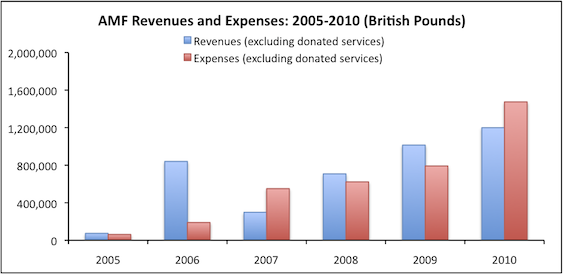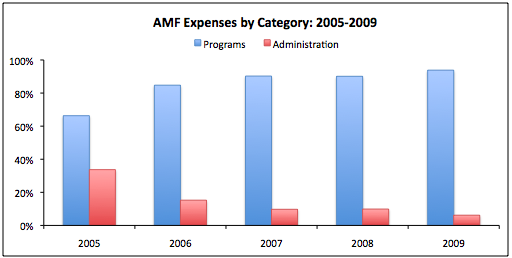We have published a more recent review of this organization. See our most recent report on AMF.
To see how we rank AMF overall, see our list of top-rated charities.
More information:
Published: 2010
Table of Contents
What do they do?
The Against Malaria Foundation (AMF) purchases insecticide-treated nets (ITNs) for distribution in the developing world.
AMF (a) reviews proposals (through its Malaria Advisory Group (MAG)) from non-profits seeking bednets,1 (b) purchases and ships nets for approved proposals,2 and (c) posts pre-distribution reports, post-distribution reports, and photos of the distribution taking place on its website.3
Does it work?
Distributing ITNs has, in the past, been shown rigorously to prevent deaths from (and other cases of) malaria. (For more, see our full report on distributing ITNs.) The conditions under which successes have been achieved are relatively unclear; we feel it is reasonable to expect impact when ITNs are used consistently and appropriately by people at risk from malaria.
When evaluating the effectiveness of an ITN distribution organization, we therefore seek to answer the following questions:
- Do the nets reach the intended destination? It appears so. AMF posts approximately 10-40 photos for each distribution. These photos mainly show nets arriving in the village, a speech or presentation before nets are handed out, people receiving nets, and sometimes, a net or two hanging in a house.4 Of the 110 distributions in 2009, 84% are documented with photos and/or videos on AMF's website and 75% have posted post-distribution reports. 95% had posted either photos/videos or a post-distribution report as of June 2010.5
- Do high-risk populations (i.e., pregnant women and children under 5, living in areas with high rates of malaria) receive them? We believe that nets reach areas with high rates of malaria, as this is one of AMF's criteria for approving proposals (and it provided us with proposals that it declined to fund because of unanswered questions about rates of malaria in the area)6 but we are unclear on the extent to which nets specifically reach children under 5 and pregnant women, who face the highest risks from malaria.7
- Do those who receive the nets install them in their homes properly? We have relatively little information about this question, as AMF does not usually perform follow-up surveys on it. One informal survey by an AMF donor suggested that some nets were not installed properly and that there is substantial room for concern.8
- Do those who receive the nets utilize them consistently over the long term? We would guess that many do and many do not. There are clear examples of ITN-distribution projects where many individuals who received nets used them such that malaria rates fell dramatically (for more, see our report on large-scale net distributions). Nevertheless, we would guess that many nets fall into disrepair or that people choose to stop using them. Unfortunately, we don't know whether this applies to very few people, a moderate number of people, or most people. AMF told us that it has begun to collect longer term monitoring reports and that the first summary reports will be available in September 2010.9 AMF has shared examples of completed survey forms with us.10
Possible negative or offsetting impact
We see relatively small risk of negative or offsetting impact from ITN distributions. It is possible that donor-funded ITN distributions end up substituting for government projects (or private, for-profit provision of ITNs) or temporarily divert local labor, but intuitively speaking, these risks do not strike us as major.
What do you get for your dollar?
We estimate that when ITN distributions are effective, $182-$1126 prevents a death from malaria and prevents 320 less severe malaria episodes. Note that cost-effectiveness could vary significantly depending on the extent to which people use ITNs and the overall effectiveness of a given distribution program. (For more on cost-effectiveness, see our full report on distributing ITNs.)
AMF's approval process adds some additional (though relatively small) cost to the program.11
Room for more funds?
We believe that additional donations to AMF would likely result in an increase in ITNs distributed. AMF provided us with several proposals that would have been approved,12 but were partially funded or unfunded due to limited funds. Two were as recent as February and April 2010.13
In an email, AMF's founder told us that with an additional $15 million, AMF would be able to cover proposals it currently cannot fund due to lack of funding and provide 1 million nets to national distribution programs in each Sierra Leone and Malawi, which would to allow them to achieve universal coverage. AMF's founder also told us that he believes that AMF could productively use up to $50 million to fund additional net distribution programs.14
Financials/other
All data is from AMF's Audited Financial Statements for 2005-2009, which are from the United Kingdom's Charity Commission website.15 Since AMF is a British charity, all figures are presented in British pounds.
Revenue and expense growth (about this metric): AMF is relatively young and relatively small. Its revenues have been somewhat unsteady after first year in existence (2005). It's expenses have risen very slightly over the past few years.

Assets-to-expenses ratio (about this metric): AMF assets-to-expenses ratio is around .7, toward the lower end of what we consider reasonable.

Expenses by program area (about this metric): AMF only runs one program, so all expenses support ITN distributions.
Expenses by IRS-reported category (about this metric): These are within the range we believe is reasonable.
Note: AMF is a British charity, and we therefore use the terms that equate to IRS-reported categories. We believe that the "charitable activities" item refers to "program expenses" and "governance costs" refer to "administration". We did not see a line item for fundraising costs on AMF's financials.

Unanswered questions
- We have several unanswered questions about AMF's impact. We do not have a strong position on the characteristics most likely to predict whether an ITN distribution program succeeds. Do AMF's ITNs reach children and pregnant women (who are most at-risk) or adult men (who are not)? Are AMF's nets properly installed in homes? Do AMF's nets remain in use and in good condition over time?
Sources
- Against Malaria Foundation. Audited financial statements:
- Against Malaria Foundation. Cape Verde summary: Rejected (PDF).
- Against Malaria Foundation. Distribution proposals: Examples of responses from Malaria Advisory Group (MAG) and follow up with proposers (DOC). (This includes notes as to why the proposals were rejected.)
- Against Malaria Foundation. Distribution proposals: Fully funded examples (June 2010) (PDF).
- Against Malaria Foundation. Distribution strategy. http://www.againstmalaria.com/Distribution_strategy.aspx (accessed June 24, 2010). Archived by WebCite® at http://www.webcitation.org/5qjYnU8Q3.
- Against Malaria Foundation. Distributions. http://www.againstmalaria.com/distributions.aspx (accessed June 24, 2010). Archived by WebCite® at http://www.webcitation.org/5qjYnlwKQ.
- Against Malaria Foundation. Madagascar summary: Rejected (PDF).
- Against Malaria Foundation. MAG notes on fully funded proposals (June 2010) (PDF).
- Against Malaria Foundation. MAG notes on proposals that could only be partially funded due to funding constraints (June 2009) (DOC).
- Against Malaria Foundation. MAG notes on proposals that could only be partially funded due to funding constraints (June 2010) (PDF).
- Against Malaria Foundation. Nsambe, Neno District, Malawi. http://www.againstmalaria.com/Distribution.aspx?DistributionID=265 (accessed June 24, 2010). Archived by WebCite® at http://www.webcitation.org/5qjYo5ueS.
- Against Malaria Foundation. Philippines summary: Open awaiting funding (PDF).
- Against Malaria Foundation. Post-distribution survey example (PDF).
- Against Malaria Foundation. Proposals that could only be partially funded due to funding constraints (June 2009) (PDF).
- Against Malaria Foundation. Proposals that could only be partially funded due to funding constraints (June 2010) (PDF).
- Against Malaria Foundation. Proposals that were rejected due to funding constraints (June 2009) (PDF).
- Anonymous AMF partner. Phone conversation with GiveWell, June 25, 2009.
- Charity Commission. The Against Malaria Foundation. http://www.charity-commission.gov.uk/ShowCharity/RegisterOfCharities/Do… (accessed June 24, 2010). Archived by WebCite® at http://www.webcitation.org/5qjYoRuHw.
- GiveWell. AMF distributions (XLS).
- GiveWell. Diseases.
- Lawson, Todd, and Christina Tottle. 2008. Field report (PDF). Uganda: Against Malaria Foundation.
- Mather, Robert. Against Malaria Foundation Founder. Phone conversation with GiveWell, April 28, 2009.
- Mather, Robert. Against Malaria Foundation Founder. Email to GiveWell (DOC), June 23, 2010.
- Mather, Robert. Against Malaria Foundation Founder. Phone conversation with GiveWell (DOC), February 11, 2011. Note that information from this conversation has not yet been added to the above review.
- 1
Against Malaria Foundation, "Distribution Strategy."
- 2
Robert Mather, phone conversation with GiveWell, April 28, 2009.
- 3
Against Malaria Foundation, "Distributions." These are available on each distribution's page. Newer (and thus not yet completed) distributions are listed first; to see photos, click through to later pages and look for a project with a filled-in, rather than grayed-out, camera icon. An example of a completed distribution with photos is at Against Malaria Foundation, "Nsambe, Neno District, Malawi."
- 4
You can view all completed distributions at Against Malaria Foundation, "Distributions." Newer (and thus not yet completed) distributions are listed first; to see photos, click through to later pages and look for a project with a filled-in, rather than grayed-out, camera icon. An example of a completed distribution with photos is at Against Malaria Foundation, "Nsambe, Neno District, Malawi."
- 5
Data taken from Against Malaria Foundation, "Distributions" on June 14, 2010. Data compiled in GiveWell, "AMF Distributions," Sheet Data. Analysis in GiveWell, "AMF Distributions," Sheet Analysis.
- 6
AMF provided us with 8 examples of rejected proposals. At least two (Proposal 47, in India, and Proposal 58, in Rwanda) appear, from comments, to be largely due to concerns about the area's rate of malaria. Against Malaria Foundation, "Distribution Proposals: Examples of Responses From Malaria Advisory Group (MAG) and Follow Up with Proposers," Against Malaria Foundation, "Cape Verde Summary: Rejected," and Against Malaria Foundation, "Madagascar Summary: Rejected."
- 7
See our discussion of malaria.
- 8
Lawson and Tottle 2008, Pgs 2-3.
- 9
Robert Mather, email to GiveWell, June 23, 2010.
- 10
Against Malaria Foundation, "Post-Distribution Survey Example."
- 11
We spoke with a representative from a charity that applied to AMF for ITNs. She said that the AMF proposal took several days to complete. However, she also noted that AMF-provided nets arrived extremely quickly, and she was happy with the cost/benefit trade-off for her organization. Anonymous AMF partner, phone conversation with GiveWell, June 25, 2009.
- 12
Against Malaria Foundation, "MAG notes on proposals that could only be partially funded due to funding constraints (June 2010)."
- 13
Against Malaria Foundation, "Phillipines Summary: Open Awaiting Funding" and Against Malaria Foundation, "Proposals That Could Only Be Partially Funded Due to Funding Constraints (June 2010)."
- 14
"Could you provide an estimate of how much in additional donations (i.e. donations above and beyond what you expect to receive in the next year) AMF could use to fund its program of providing bed nets to partner organizations in the next year?
One answer to this question is US$15m. This would allow us to fund 2 x 1 million nets for distribution in two African countries (candidates include Sierra Leone and Malawi: in both cases nets have been allocated to the countries from other sources but they are approximately one million nets short of being able to achieve universal coverage...Million nets would cost between $8.5-9m. The additional $6-6.5m would fund new distribution proposals that we receive. Another answer to this question is $50m or indeed more as there is a huge need for nets and there are Distributions and Programmes we can identify now that need in excess of 10 million nets." Robert Mather, email to GiveWell, June 23, 2010. - 15
Charity Commission, "The Against Malaria Foundation."
